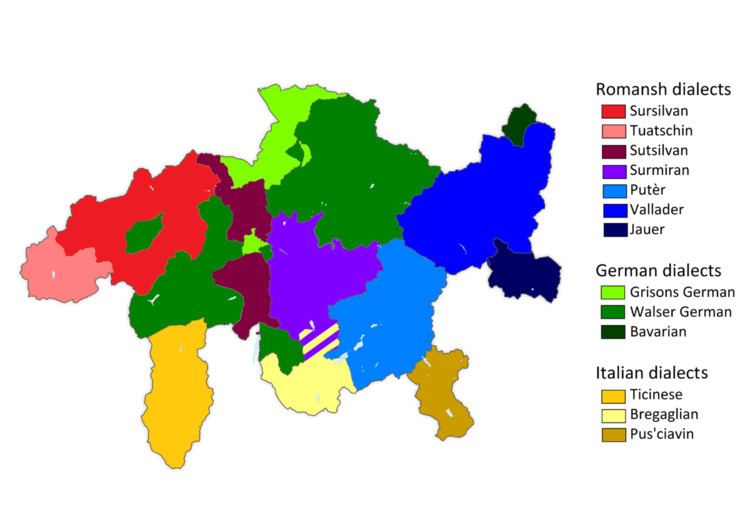 | ||
Sursilvan ( [suʁsilˈvan] or romontsch sursilvan [ʁoˈmɔntʃ suʁsilˈvan]) is a group of dialects of the Romansh language spoken in the Swiss district of Surselva. It is the most widely spoken variety of Romansh with 17,897 people within the Surselva District (54.8%) naming Romansh as a habitually spoken language in the Swiss census of 2000. The most closely related variety is Sutsilvan, which is spoken in the area located to the east of the district.
Contents
The name of the dialect and the Surselva District is derived from sur 'above' and selva 'forest', with the forest in question being the Uaul Grond in the area affected by the Flims Rockslide. The word selva itself has fallen out of use in modern Sursilvan, with the most common word for forest being uaul , an Old High German loanword. Selva is only used for in a few more recent terms such as selvicultura 'forestry', selvicultur 'forest officer', or cavrer selvadi 'Long-eared owl'.
Distribution
Sursilvan is used across most of the Surselva District, with the exception of the Walser villages of Obersaxen, Vals, St. Martin and Safiental. Outside of the Surselva District, Flims is also part of the Sursilvan dialect area. In addition, Sursilvan was previously used as the written Romansh language of parts of the Sutsilvan dialect area. When a separate Sutsilvan written language was introduced in 1944, the villages of Bonaduz, Rhäzüns, Domat/Ems and Trin retained Sursilvan as their written language. In addition, Sursilvan was previously used in the Surmiran dialect area as the language of church, but has now been replaced by Standard Surmiran and Rumantsch Grischun.
Most municipalities in which Sursilvan is the traditional language still have a Romansh-speaking majority today. The exceptions are Flims, Laax, Schnaus, Ilanz, Castrisch, Surcuolm, and Duvin. In all of these, except for Flims, however, a majority of people reported in the 2000 Swiss census to use Romansh daily, even if only a minority named it as their language of best command. In about half of the Sursilvan villages, Romansh is the language of best command of over 70% or 80%. The highest percentage is found in Vrin with over 95%. As a daily language, it is used in nearly all municipalities by at least 70%, in about half by more than 80%, and in a third by over 90%. Overall across the Sursilvan dialect area, in the census of 2000, 70.1% named Romansh as a habitually used language, while 58.3% named it as their language of best command.
Orthography
Sursilvan spelling mostly follows a phonemic system.
Literature
Sursilvan literature is published among others by the Lia Rumantscha in Chur.
Sample
The fable The Fox and the Crow by Jean de La Fontaine in Sursilvan, as well as a translation into English, the similar-looking but noticeably different-sounding dialect Sutsilvan, and Rumantsch Grischun.
